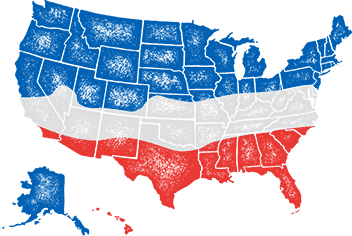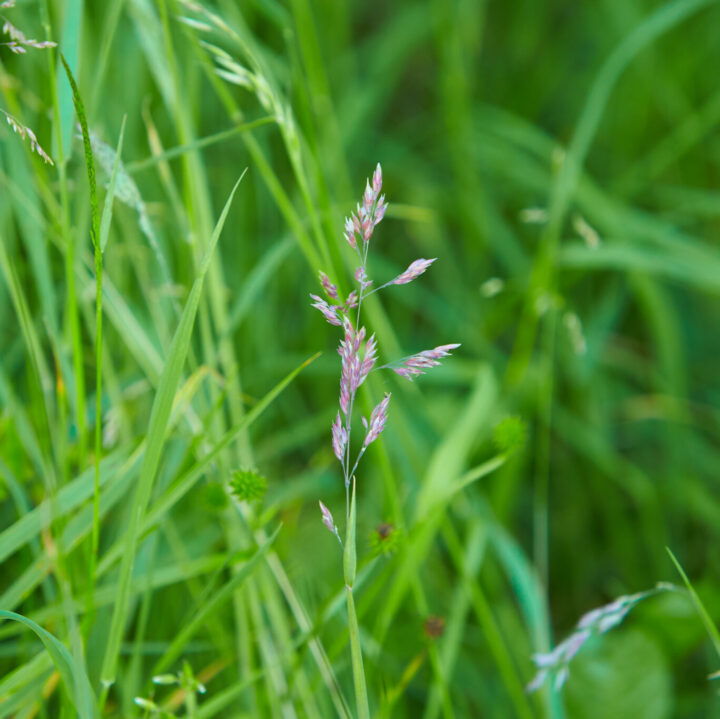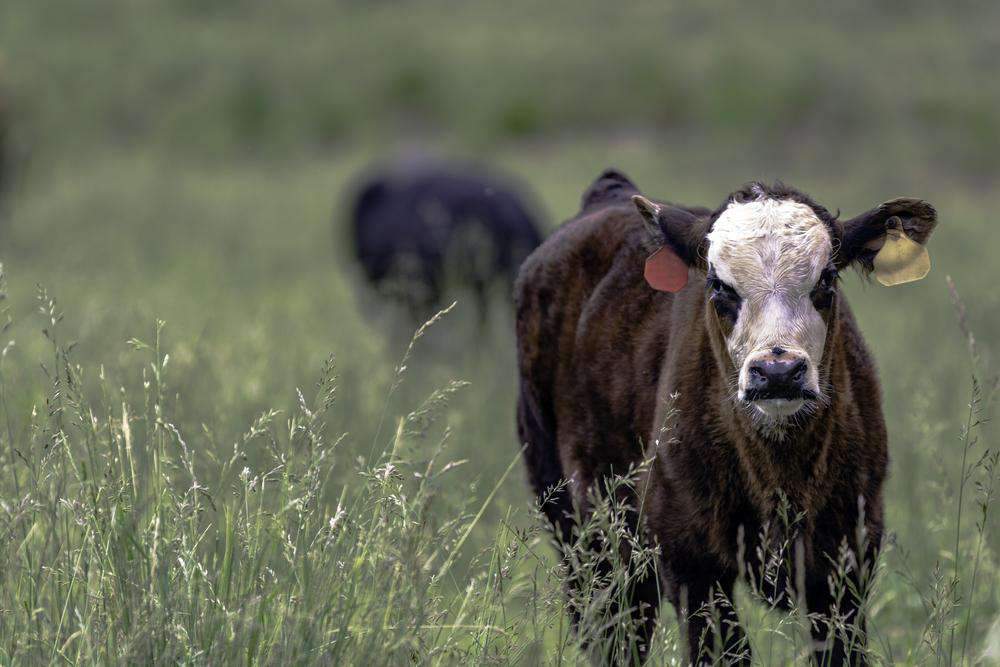
- When to plant:
- Spring, Fall
- Fertilizer:
- Hancock's 16-04-08 Lawn & Pasture Fertilizer
- Seeding rate:
- 25 - 30 lbs per acre
- Overseeding rate:
- 15 - 20 lbs per acre
- Seeding depth:
- 1/4 - 1/2 inch
- Ideal ph:
- 5.5 - 7.5
- Gmo:
- No
- Inoculant needed:
- No
- Coated or raw:
- Raw
- Lifecycle:
- Perennial
- Climate zones:
- Cool Season, Transition Zone
Hancock's Forage Tall Fescue Grass Seed is certified endophyte-free, which makes it an ideal fescue species for pasture, hay production, show arenas and race tracks, as endophytes are harmful to horses and other livestock. It shows similar resistance to brown patch, pythium and red thread diseases. Hancock's Forage Tall Fescue grows well on soils low in fertility but is better adapated to fertile conditions. It will produce top growth even late into the fall in the southern U.S. Our Hancock's Forage Tall Fescue is tolerant to many climatic challenges such as cold, drought and heat stress. It is also tolerant of many soil challenges including poor drainage and a wide range of pH levels while being highly palatable and resistant to over grazing.
Product Information
- Application or Use: Pasture, Cattle Forage, Livestock Grazing, Erosion Control, Cover Crop, Hay Production
- Germination Time: 14 - 21 days, under optimal conditions
- Growing Locations: Transition Zone & Cool Season
- Height: 8 - 20 inches
- Sunlight Requirements: 4+ hours, full sun for best results
- Advantages: Certified endophyte-free, which makes it an ideal Fescue species for pasture, hay production, show arenas and race tracks, as endophytes are harmful to horses and other livestock.
- When to Plant: Recommended planting time is spring and fall when night time temperatures are consistently below 65 degrees but once established will produce top growth when soils are as cold as 40 degrees F.
Product Details
- Endophyte-free
- Variety: Fawn
- Improved variety over Kentucky 32 Fescue
- Heat and drought-tolerant
- Excellent choice for erosion control
- High forage and hay yields
- Rapid germination and great seedling vigor
- Adapted to a wide range of soil types and pH
- Excellent for applications that involve livestock and horses
Product Information
Hancock's Forage Tall Fescue Grass Seed is an endophyte-free Fescue variety named Fawn Fescue. As pasture, forage quantity, digestibility, and palatability are the three main factors in selecting a pasture grass and managing it properly. With proper management, Hancock's Forage Tall Fescue will adequately cover all three. It is adapted to a wide range of soils, climates, and pasture management systems.
If you are looking for fast establishment, vigorous enough growth to withstand adverse conditions and disease, and a turf that will last for years, then continue reading about Hancock's Forage Tall Fescue. It features excellent seedling vigor, vigorous growth, high resistance to brown patch, pythium, and red thread diseases, excellent drought tolerance, shade-tolerance, and it out competes weeds, especially poa annua. It is fantastic for low maintenance applications.
Our Hancock's Forage Fescue outgrows problems caused by diseases, insects, shade, weeds, and all those other factors that attack a lawn and shortens turf life. It has a medium green color, with open crowns that allow for good airflow, which reduces the incidence of turf diseases. The wide leaf blades collect more sunlight, allowing for a suitable turf for dense shade pastures. Deep roots go after soil moisture to allow greater drought tolerance. All of these factors add years to the life of the pasture, paddock or show arena.
*Product packaging may appear different than what is pictured.
For the highest success in establishing a new Fescue pasture, care must be taken to completely kill the old stand, which may consist of weedy grasses, broadleaf weeds, and endophyte-infected grasses. A non-selective herbicide such as glyphosate is ideal. This may be coupled with a summer fallow program, a summer annual forage program, or a combination of methods. It is important to completely kill old grass crowns, and sprout any remnant seed from undesirable plants.
The best time to establish your new Hancock's Forage Fescue pasture is in the fall or early spring, depending on soil and moisture conditions. The new stand may be no-till drilled directly into dead sod, depending on timing and conditions. Otherwise, shallow-till the surface, harrow smooth, and drill 25-30 lbs seed/acre. Drill no deeper than one-half inch. If broadcasting the seed, slightly increase your seeding rate and lightly harrow in. Roll lightly to help cover seed, firm the seedbed, and provide a good seed/soil contact. Make sure you have adjusted the pH and applied a good starter fertilizer as recommended by your extension agent or fertilizer dealer.
Do not graze the new pasture until the stand is well established. This normally means spring for a fall planted stand, or early summer for a spring-planted stand. The pasture should be about six in. tall before the first light grazing. Do not graze in frozen or extremely wet conditions, as this will damage the stand and reduce stand life. Control broadleaf weeds with recommended herbicides, and apply fertilizer as indicated by soil test.
Properly established and maintained, a tall fescue pasture will give many years of high yields of high quality forage.
Rotational grazing is considered the best system to maintain pasture health and provide the most nutritious forage. Depending on the pasture size and the number of livestock, dividing the pasture into several smaller paddocks, and then intensively grazing each paddock in rotation, will give the pasture time to recover and will keep the feed fresher, with less traffic damage in areas like gates and around water sources.
Low maintenance or low input pastures will require less time and management, but will result in considerably less productivity and pasture persistence, as well as reduced average daily gains. Overgrazing will also shorten stand life and compromise productivity. A well maintained pasture, with proper grazing management, will be persistent and profitable.
For hay, cutting forage Fescue in the early boot stage will give the best balance between hay yield and nutritional content. Cutting earlier will reduce yield, and cutting later will reduce the quality of the hay. A properly harvested first cutting will open the way to subsequent cuttings that are larger with very high quality forage. Proper soil management will result in the highest hay yields with higher quality. Consult with your extension agent or fertilizer dealer for local recommendations. Always cut no shorter than three inches to give the plants a better chance for regrowth. Also, always leave three inch stubble going into winter where winter kill may be a factor.
For horse pasture, quantity, quality, and type of pasture for horses is dependent upon the type of operation and nutritional needs. A breeding mare operation will have specific needs different than keeping a pleasure horse. Besides the needs of the horse, the region, climate, and management options must be considered. Low-maintenance and low-input pastures will require less management, but may be considerably less productive with lower quality forage. A well maintained forage tall fescue pasture, with proper fertilization and grazing management, should satisfy the nutritional needs of most horses, regardless of their purpose.
Hay production for horses centers on nutritional quality, palatability, and digestibility. Cutting forage tall fescue at the early boot stage will strike a balance between hay quality and forage yield. For horses, it is even more important for hay to have adequate long fiber, to aid in keeping the digestive system active and healthy. Cutting too early lowers fiber content, and cutting too late will lower nutritional quality and palatability.
When choosing to start a new lawn, remove old vegetation by using a de-thatcher, power rake or tiller to kill the existing vegetation. Rake or drag the area to remove debris and dead grass for a clean area. Ensure the soil is leveled and loosened to allow the seed to have good soil contact once spread on a clean seed bed.
If you have an area with heavy weed coverage, we recommend starting fresh by killing and removing the existing vegetation. If you choose to use chemicals, herbicides or fertilizers, you must check with the product's manufacturer prior to planting new seed to ensure the proper waiting period.
When overseeding an existing area, mow your lawn at the lowest setting and bag the clippingsx. Rake or drag any areas that have dead thatch or debris.

Seed Quality
Hancock Seed is dedicated to delivering the best seeds possible to our customers. Hancock Seed grows and harvests many of our products, and we acquire the majority of the rest from other family farmers.
All these seeds are processed, packaged and shipped from Hancock Farm. This helps us ensure that our high standards are met. Unlike much of the competition, we refuse to sell you a seed that was not gathered during the last harvest. You will always receive fresh product from Hancock.
Every seed we grow comes with 40 years of experience behind it...you can rest assured that all of our products are cultivated in a method that assures its potential for growth.

Your cart ( 0 )

Hancock's Forage Tall Fescue Grass Seed is certified endophyte-free, which makes it an ideal fescue species for pasture, hay production, show arenas and race tracks, as endophytes are harmful to horses and other livestock. It shows similar resistance to brown patch, pythium and red thread diseases. Hancock's Forage Tall Fescue grows well on soils low in fertility but is better adapated to fertile conditions. It will produce top growth even late into the fall in the southern U.S. Our Hancock's Forage Tall Fescue is tolerant to many climatic challenges such as cold, drought and heat stress. It is also tolerant of many soil challenges including poor drainage and a wide range of pH levels while being highly palatable and resistant to over grazing.
Product Information
- Application or Use: Pasture, Cattle Forage, Livestock Grazing, Erosion Control, Cover Crop, Hay Production
- Germination Time: 14 - 21 days, under optimal conditions
- Growing Locations: Transition Zone & Cool Season
- Height: 8 - 20 inches
- Sunlight Requirements: 4+ hours, full sun for best results
- Advantages: Certified endophyte-free, which makes it an ideal Fescue species for pasture, hay production, show arenas and race tracks, as endophytes are harmful to horses and other livestock.
- When to Plant: Recommended planting time is spring and fall when night time temperatures are consistently below 65 degrees but once established will produce top growth when soils are as cold as 40 degrees F.
Product Details
- Endophyte-free
- Variety: Fawn
- Improved variety over Kentucky 32 Fescue
- Heat and drought-tolerant
- Excellent choice for erosion control
- High forage and hay yields
- Rapid germination and great seedling vigor
- Adapted to a wide range of soil types and pH
- Excellent for applications that involve livestock and horses
Product Information
Hancock's Forage Tall Fescue Grass Seed is an endophyte-free Fescue variety named Fawn Fescue. As pasture, forage quantity, digestibility, and palatability are the three main factors in selecting a pasture grass and managing it properly. With proper management, Hancock's Forage Tall Fescue will adequately cover all three. It is adapted to a wide range of soils, climates, and pasture management systems.
If you are looking for fast establishment, vigorous enough growth to withstand adverse conditions and disease, and a turf that will last for years, then continue reading about Hancock's Forage Tall Fescue. It features excellent seedling vigor, vigorous growth, high resistance to brown patch, pythium, and red thread diseases, excellent drought tolerance, shade-tolerance, and it out competes weeds, especially poa annua. It is fantastic for low maintenance applications.
Our Hancock's Forage Fescue outgrows problems caused by diseases, insects, shade, weeds, and all those other factors that attack a lawn and shortens turf life. It has a medium green color, with open crowns that allow for good airflow, which reduces the incidence of turf diseases. The wide leaf blades collect more sunlight, allowing for a suitable turf for dense shade pastures. Deep roots go after soil moisture to allow greater drought tolerance. All of these factors add years to the life of the pasture, paddock or show arena.
*Product packaging may appear different than what is pictured.
For the highest success in establishing a new Fescue pasture, care must be taken to completely kill the old stand, which may consist of weedy grasses, broadleaf weeds, and endophyte-infected grasses. A non-selective herbicide such as glyphosate is ideal. This may be coupled with a summer fallow program, a summer annual forage program, or a combination of methods. It is important to completely kill old grass crowns, and sprout any remnant seed from undesirable plants.
The best time to establish your new Hancock's Forage Fescue pasture is in the fall or early spring, depending on soil and moisture conditions. The new stand may be no-till drilled directly into dead sod, depending on timing and conditions. Otherwise, shallow-till the surface, harrow smooth, and drill 25-30 lbs seed/acre. Drill no deeper than one-half inch. If broadcasting the seed, slightly increase your seeding rate and lightly harrow in. Roll lightly to help cover seed, firm the seedbed, and provide a good seed/soil contact. Make sure you have adjusted the pH and applied a good starter fertilizer as recommended by your extension agent or fertilizer dealer.
Do not graze the new pasture until the stand is well established. This normally means spring for a fall planted stand, or early summer for a spring-planted stand. The pasture should be about six in. tall before the first light grazing. Do not graze in frozen or extremely wet conditions, as this will damage the stand and reduce stand life. Control broadleaf weeds with recommended herbicides, and apply fertilizer as indicated by soil test.
Properly established and maintained, a tall fescue pasture will give many years of high yields of high quality forage.
Rotational grazing is considered the best system to maintain pasture health and provide the most nutritious forage. Depending on the pasture size and the number of livestock, dividing the pasture into several smaller paddocks, and then intensively grazing each paddock in rotation, will give the pasture time to recover and will keep the feed fresher, with less traffic damage in areas like gates and around water sources.
Low maintenance or low input pastures will require less time and management, but will result in considerably less productivity and pasture persistence, as well as reduced average daily gains. Overgrazing will also shorten stand life and compromise productivity. A well maintained pasture, with proper grazing management, will be persistent and profitable.
For hay, cutting forage Fescue in the early boot stage will give the best balance between hay yield and nutritional content. Cutting earlier will reduce yield, and cutting later will reduce the quality of the hay. A properly harvested first cutting will open the way to subsequent cuttings that are larger with very high quality forage. Proper soil management will result in the highest hay yields with higher quality. Consult with your extension agent or fertilizer dealer for local recommendations. Always cut no shorter than three inches to give the plants a better chance for regrowth. Also, always leave three inch stubble going into winter where winter kill may be a factor.
For horse pasture, quantity, quality, and type of pasture for horses is dependent upon the type of operation and nutritional needs. A breeding mare operation will have specific needs different than keeping a pleasure horse. Besides the needs of the horse, the region, climate, and management options must be considered. Low-maintenance and low-input pastures will require less management, but may be considerably less productive with lower quality forage. A well maintained forage tall fescue pasture, with proper fertilization and grazing management, should satisfy the nutritional needs of most horses, regardless of their purpose.
Hay production for horses centers on nutritional quality, palatability, and digestibility. Cutting forage tall fescue at the early boot stage will strike a balance between hay quality and forage yield. For horses, it is even more important for hay to have adequate long fiber, to aid in keeping the digestive system active and healthy. Cutting too early lowers fiber content, and cutting too late will lower nutritional quality and palatability.
Instructions
When choosing to start a new lawn, remove old vegetation by using a de-thatcher, power rake or tiller to kill the existing vegetation. Rake or drag the area to remove debris and dead grass for a clean area. Ensure the soil is leveled and loosened to allow the seed to have good soil contact once spread on a clean seed bed.
If you have an area with heavy weed coverage, we recommend starting fresh by killing and removing the existing vegetation. If you choose to use chemicals, herbicides or fertilizers, you must check with the product's manufacturer prior to planting new seed to ensure the proper waiting period.
When overseeding an existing area, mow your lawn at the lowest setting and bag the clippingsx. Rake or drag any areas that have dead thatch or debris.





















